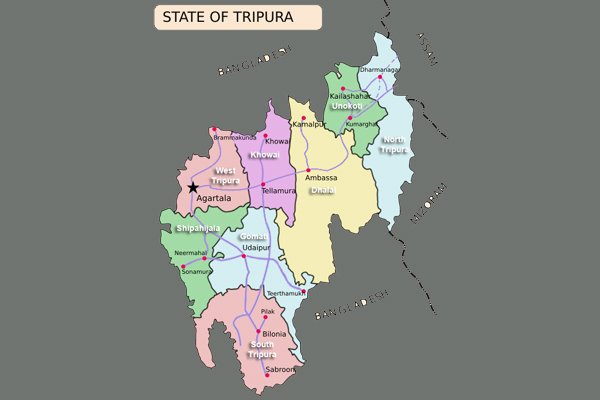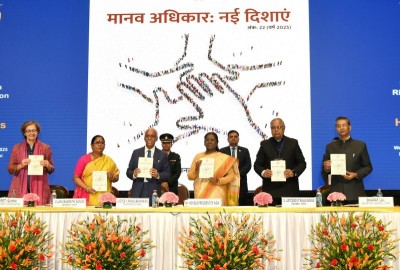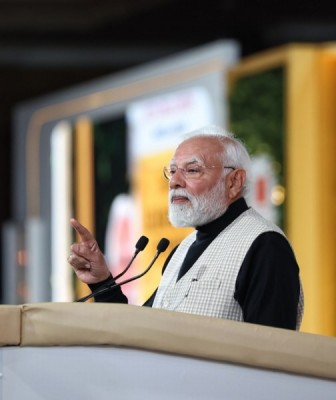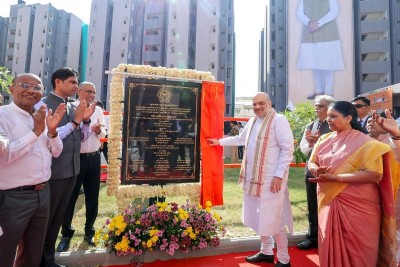
Tripura: Fight to the Finish
Significantly, at its peak in 2004, militancy in Tripura had claimed as many as 514 lives, including 453 civilians, 45 militants and 16 Security Force (SF) personnel.
According to SATP data, the four fatalities in 2014, in three incidents of killing, included two civilians and two SF personnel. A civilian driver, Himari Rangtor, and a Border Security Force (BSF) trooper, Adil Abbas, were killed when suspected cadres of the Biswamohan faction of the National Liberation Front of Tripura (NLFT-BM) ambushed a BSF vehicle at Pusparam Para in North Tripura District on November 17, 2014. Suspected NLFT-BM militants also killed a BSF trooper, Biswas Kumar, in an ambush at Malda Para in Dhalai District on October 23, 2014. Earlier, on June 12, 2014, the body of a surrendered NLFT militant, identified as Samindra Debbarma, was recovered from Vidyabill area in Khowai District. Prior to these two killings, the last civilian fatality had taken place on January 31, 2011, when NLFT militants killed the in-charge of Shewapara border fencing site of National Building Construction Corporation (NBCC), identified as C.N. Muni, and injured his driver, at a remote tribal hamlet in North Tripura District near the Indo-Bangladesh border.
Though no militant was killed through 2014, the State witnessed the killing of SF personnel after a long hiatus. The last SF fatality before the two 2014 killings was recorded on August 6, 2010, when two BSF troopers were killed in an improvised explosive device (IED) blast carried out by NLFT-BM militants in Ratia under the Chawmanu Police Station of Dhalai District. Meanwhile, the Inspector General of Border Security Force (BSF, Tripura Frontier), B.N. Sharma, stated on November 28, 2014, "After two ambushes on BSF troops, the operational strategy has been changed. We have decided to send jawans in strong numbers to foil their attempt."
NLFT-BM was responsible for three killings in 2014, while the killing of the surrendered NLFT militant remained unattributed. No confirmed activity by the All Tripura Tiger Force (ATTF) was reported in the State through 2014.
In a worrying development, however, the Indigenous People's Front of Tripura (IPFT), on September 12, 2014, announced that its party members would go to New Delhi to meet Union Home Minister (UHM) Rajnath Singh and Union Tribal Affairs Minister Jual Oram, to press for its demand for a separate State to be carved out of Tripura. Though no further information about this announcement is available, Chief Minister (CM) Manik Sarkar on December 29, 2014, stated, "Nothing will be allowed to revive this dead phenomenon. Tripura simply does not need a separate State, as the TTAADC [Tripura Tribal Areas Autonomous District Council], based on the Sixth Schedule and spread over 68.10 per cent of the State's territory, is a vibrant institution taking good care of the socio-economic and political interests of the indigenous communities." The tribal areas of the State are presently governed by TTAADC under Schedule VI of the Constitution. The formation of a separate Telangana State, which was carved out of Andhra Pradesh in South India on June 2, 2014, has revived a slew of similar demands across the Northeast.
Further, as Chief Minister Sarkar observed, on January 3, 2015, "The insurgency has not been uprooted yet, despite all out efforts. Militants are still on the operational mode in some interior places of the State. Police has to be more proactive along with the Central Paramilitary Force BSF, which is deployed in the border, has to be more alert and active. If Tripura Police, TSR [Tripura State Rifles] and BSF jointly with the public support, go for counter insurgency . then militancy can be totally wiped out."
The State Government, on November 29, 2014, decided to extend the Armed Forces Special Powers Act (AFSPA) - 1958 for another six months. AFSPA was first enforced in Tripura in 1997, when terrorism was at its peak. In view of the improvement in the situation and the lessening of terrorist activities, the Tripura Government had, in June 2013, reviewed its application and reduced the operational areas of the Act to 30 Police Station areas, from the earlier 40.
However, Director General of Police (DGP) K. Nagaraj, on January 4, 2015, asserted that insurgency had been largely contained in the State, and that only eight militant-related incidents had been registered during 2014, as compared to nine such incidents in 2013. The number of abduction cases registered had reduced to eight in 2014, against ten in 2013, and only one abducted person was still in militant captivity. According to the SATP data, however, 10 persons were abducted in six such incidents in 2014, as against three such incidents in which seven persons were abducted in the preceding year. In addition, SFs in the State arrested four militants [all NLFT-BM cadres] in three incidents in 2014, adding to thirteen such arrests in 2013. In one such incident on December 4, 2014, BSF troopers, arrested NLFT-BM 'commander' Amarjeet Debbarma (35), from the Raisyabari market in the Gandacherra Sub-division in Dhalai District.
31 militants [18 of NLFT-BM, 10 of the Bru National Army (BNA), and three of the Bru Democratic Front of Mizoram (BDFM)] surrendered during 2014, as against 14 surrenders in 2013. In one major incident of surrender, 10 BNA militants surrendered to Assam Rifles (AR) personnel at Kanchanpur Sub-division in the North Tripura District, on May 7, 2014. The surrendered militants included the 'second in command' of BNA, Singhrak aka Simanjoy, and 'third in command' Chunsa Rai. Meanwhile, on September 4, 2014, the Tripura Government decided to withdraw court cases against surrendered militants, except those of crimes committed against women. An unnamed official of the Tripura Home Department disclosed, "Chief Minister Manik Sarkar said the State Government has decided to withdraw court cases against the former militants to lure underground terrorists to lay down arms and join mainstream of life."
Meanwhile, neighboring Bangladesh continued its support to India's fight against terror groups operating in Tripura in particular and the Northeast region in general. Significantly, on November 29, 2014, SFs in Bangladesh killed eight NLFT-BM militants in the Naraicherra area near Segun Bangan of Chittagong Hill Tracts (CHT). The operation had been launched following intelligence inputs provided by Indian agencies. Similarly, Bangladesh SFs launched an operation between November 24 and 28, 2014, destroying several NLFT-BM hideouts in the Khagrachhari District of Bangladesh, forcing 36 NLFT-BM cadres to flee to the nearby Bandarban District (Bangladesh). This operation also led to the arrest of NLFT-BM 'commander' Kwaplai Debbarma alias Karna (33) from the house of a former ATTF 'commander' Jewel Debbarma, in the Char Mile area of Khagrachhari District in Bangladesh. Earlier, a March 16, 2014, report had indicated that NLFT-BM was facing its worst-ever crisis, with lower cadres strongly advocating a truce with the Indian Government. Reports also suggest that NLFT-BM militants staying in the Bangladeshi camps were highly dissatisfied with misappropriation of funds by senior 'commanders', a growing resource crunch, food crises and the wide gap between the lifestyles of the leadership and the cadres.
Significantly, two of the major outfits - NLFT-BM and ATTF - still operating in Tripura are reported to have at least 32 camps in Bangladesh. BSF Inspector General (Tripura Frontier) B. N. Sharma, on November 28, 2014, disclosed that, of these hideouts, NLFT-BM accounted for 21 camps.
NLFT-BM suffered a split in early December 2014, with 'commander' Prabhat Jamatya (39) leaving the group's camp in CHT with more than 25 followers and a large cache of arms and ammunition. The NLFT-Prabhat faction (NLFT-P) is reportedly headquartered in the sprawling house of a retired Bangladeshi Policeman in Rajghat under the Chunarughat Sub-district of Habiganj District in Bangladesh. These militants have also started sending "tax notices" to Tripura residents from across the border.
Police led operations in the State have forced both the principal militant formations, NLFT-BM and ATTF, to restrict their operations, working from CHT in Bangladesh. Though the Bangladesh Government is providing enormous support, the unfenced areas along the Indo-Bangladesh border continue to facilitate the easy movement of militants into the State. Union Minister of State for Home Affairs Kiren Rijiju on August 13, 2014, told the Rajya Sabha (Upper House of Parliament) that, out of the 848-kilometers of the Tripura-Bangladesh Border, 782.46-kms have been fenced while 65.54-kms of border remain to be fenced. Moreover, as Tripura Governor Padmanava Balkrishna Acharya, expressing dissatisfaction with the fencing work along Indo-Bangladesh border on October 14, 2014, observed, "The fence can be easily cut and breached any time. The quality of work does not justify the huge spending incurred in erecting it."
Tripura has secured extraordinary success through its model of a Police-led counter-insurgency campaign against what was once a raging militancy. This success was secured by establishing a remarkable police presence, with 636 Policemen per 100,000 population and 225.2 Policemen per 100 square kilometers, and by dramatic improvements in training, equipment and leadership. The residual problems that persist demand an acute operational focus in the border areas. Effective border fencing, the operationalization all 64 Border out Posts, greater area domination, and joint patrolling with Bangladeshi Forces can help mop up the straggling remnants of the insurgency.
Support Our Journalism
We cannot do without you.. your contribution supports unbiased journalism
IBNS is not driven by any ism- not wokeism, not racism, not skewed secularism, not hyper right-wing or left liberal ideals, nor by any hardline religious beliefs or hyper nationalism. We want to serve you good old objective news, as they are. We do not judge or preach. We let people decide for themselves. We only try to present factual and well-sourced news.







